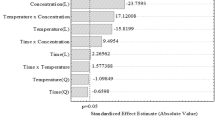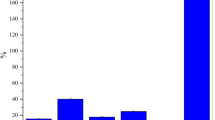Abstract
Apos tichopus japonicus Selenka is an ideal tonic food that is used traditionally in many Asian countries, and it contains many bioactive substances, such as antioxidant, antimicrobial, and anticancer materials. To convert waste liquid generated during production into a useful resource, extract from waste liquid was isolated by column chromatography and studied by the pyrogallol autoxidation and 1,10-phenanthroline-Fe2+ oxidation methods. Results show that the extract scavenged about 91% of the superoxide anion radical at a concentration of 1.4 mg/mL and 24% of the hydroxyl radical at 3.3 mg/mL. Four compounds were isolated and identified from the extract: 2,4-dihydroxy-5-methyl-1,3-azine; 2,4-dihydroxy-1,3-diazine; 3-O-[β-D-quinovopranosyl-(1→2)-4-O-sodium sulfate-β-D-xylopranosyl]-holosta-9(11)-ene-3β,12α,17α-triol; and 24-ethyl-5α-cholesta-7-ene-3β-O-β-D-xylopyranoside. All of these compounds are known in A. japonicus, and were found in the waste liquid for the first time.
Similar content being viewed by others
References
Albano R M, Mourão P A S. 1986. Isolation, fractionation, and preliminary characterization of a novel class of sulfated glycans from the tunic of Styela plicata (Chordata Tunicata). Biological Chemistry, 261(2): 758–765.
Butterfield D A, Castenga A, Pocernich C B, Drake J, Scapagnini G, Calabrese V. 2002. Nutritional approaches to combat oxidative stress in Alzheimer’s diseases. Journal of Nutritional Biochemistry, 13(8): 444–461.
Chen Q, Wu L J, Ruan L J. 2002. Chemical studies on the constituents of Lophatherum gracile Brongn (II). Journal of Shenyang Pharmaceutical University, 19(4): 257–259. (in Chinese with English abstract)
Conand C, Byrne M. 1993. A review of recent developments in the world sea cucumber fisheries. Marine Fisheries Review, 55: 1–13.
Czernecki S, Valery J M. 1991. An efficient synthesis of 3′-azido-3′-deoxythymidine (AZT). Synthesis, 3: 239–240
Fan H Z. 2001. Sea cucumber: ginseng of the sea. Chinese Journal of Marine Drugs, 4: 37–44. (in Chinese with English abstract)
Guo Q Z, Zhao E L, Bai J H. 2008. Study on antioxidant performance of extracts of seabuckthorn leaves. Chemistry & Bioengineering, 25(3): 58–59. (in Chinese with English abstract)
Hamel J F, Mercier A. 1997. Sea cucumbers: current fishery and prospects for aquaculture. Aquaculture Magazine, 23: 42–53.
Han Y Q, Feng X M, Guan H S. 2005. The progress in research of sea cucumber glycosides. Natural Product Research and Development, 17(5): 669–672. (in Chinese with English abstract)
Hsieh C L, Yen G C. 2000. Antioxidant actions of du-zhong (Eucommia ulmoides Oliv.) toward oxidative damage in biomolecules. Life Science, 66(15): 1 387–1 400.
Huang R M, Wang B, Liu Y H. 2009. A review of chemical constituents and bioactivities in sea cucumber. Chinese Traditional Patent Medicine, 31(8): 1 263–1 269. (in Chinese)
Jiang J, Yang B L, Tai Y. 2004. Studies on resources and bioactive substances of sea cucumber. Letters in Biotechnology, 15(5): 537–540. (in Chinese with English abstract)
Jin M, Cai Y X, Li J R, Zhao H. 1996. 1,10-Phenanthroline-Fe2+ oxidative assay of hydroxyl radical produced by H2O2 /Fe2+. Progress in Biochemistry and Biophysics, 23(6): 553–555. (in Chinese with English abstract)
Jing Y S, Wu L F, Zhang Z D, Yang J. 2011. Evaluation on antioxidant activities of extracts from Berchemia polyphylla var. leioclada. Chinese Journal of Gerontics, 31(7): 1 179–1 180. (in Chinese with English abstract)
Kitagawa I, Inamoto T, Fuchida M, Kobayahi M, Nishino T, Kyogoku Y. 1980. Structure of echinoside A and B, two antifungal oligoglycosides form the sea cucumber Actinopyga echinites (Jaeger). Chemical and Pharmaceutical Bulletin, 28(5): 1 651–1 653.
Kitagawa I, Kobayashi M, Hori M, Kyogoku Y. 1989. Marine natural products. XVIII. Four lanostane-type triterpene oligoglycosides, bivittosides A, B, C, and D, from the okinawan sea cucumber Bohadschia bivittata Mitsukuri. Chemical and Pharmaceutical Bulletin, 37(1):61–67.
Li Z P, Fu P, Yang W Y, Xu Z. 2004. Study on the freeze-dry processing technology of Stichopus japonicas. Marine Fisheries, 26(1): 52–56. (in Chinese with English abstract)
Liu X L, Qian B C. 1997. The overview of natural native substance in Japan. Chinese Journal of Marine Drugs, 1: 45–49. (in Chinese)
Mourão P A, Bastos I G. 1987. Highly acidic glycans from sea cucumbers: Isolation and fractionation of fucose-rich sulfated polysaccharides from the body wall of Ludwigothurea grisea. European Journal of Biochemistry, 166(3): 639–645.
Nigrelli R F. 1952. The effects of holothurin on fish and mice with sarcoma 180. Zoologica New York, 37: 89–90.
Pryor W A. 1982. Free radical biology: xenobiotics, cancer, and aging. Annals of the New York Academic Science, 393(1): 1–22.
Qi H M, Zhang Q B, Zhao T T, Hu R G, Zhang K, Li Z E. 2006. In vitro antioxidant activity of acetylated and benzoylated derivatives of polysaccharide extracted from Ulva pertusa (Chlorophyta). Bioorganic & Medicinal Chemistry Letters, 16(9): 2 441–2 445. (in Chinese with English abstract)
Qian Z J, Jung W K, Kim S K. 2008. Free radical scavenging activity of a novel antioxidative peptide purified from hydrolysate of bullfrog skin, Rana catesbeiana Shaw. Bioresource Technology, 99(6): 1 690–1 698.
Qiu P X, Li M T, Tang X L, Su X W, Lin S Z, Yan G M. 2000. Protective effects of polysaccharide from Holothuria atra on apoptosis of cortical neurons induced by amyloid β-protein. Chinese Traditional and Herbal Drugs, 31(4): 271–274. (in Chinese with English abstract)
Qiu W R, Shen R K. 1995. Thymidine synthesized by enzyme method. Journal of Chinese Medical Industry, 26(9): 424–427. (in Chinese with English abstract)
Securities Times. 2012. Yiqiao Miaoye increase nearly 8 hundred millions into sea cucumber breeding. 6: 12, http://finance.eastmoney.com/news/1354,20120612210739643.html. (in Chinese)
Shan C Y, Ren H R, He H L, Zhang W M. 2009. Study on antioxidant effective of polysaccharides from dioscarea subcalva Prain et Burk. Food and Fermentation Industries, 35(12): 86–89. (in Chinese with English abstract)
Shan L, Zhang W D, Zhang C, Su J, Liu R H, Zhou G. 2005. Investigation on antitumor activity of saponins. Chinese Herb Medicine, 36(2): 295–298. (in Chinese with English abstract)
Su Y C, Liu S J, Wu C Y. 2009. Optimization of the preparation procedure and the antioxidant activity of polypeptide from sea cucumber. Journal of Fujian Fisheries, 2: 6–10. (in Chinese with English abstract)
Yuan W H, Yi Y H, Xue M, Zhang H W, La M P. 2008. Two antifungal active triterpene glycosides from sea cucumber Holothuria (Microthele) axiloga. Chinese Journal of Natural Medicines, 6(2): 105–108.
Yuan W P, Liu C H, Wang X J, Meng X M, Zhang J S, Xia X K, Liu X, Zhang Y G, Jia A R. 2011a. Study of holothurian glycosides extracted processing from the processing liquid waste of sea cucumber Apostichopus japonicus. Science and Technology Innovation Herald, 2: 14–15. (in Chinese with English abstract)
Yuan W P, Liu X, Fan T J, Zhang Y G, Xia X K, Liu C H. 2011b. A isolation and structure identification of several holothurian glycosides compounds from the processing liquid waste of sea cucumber Apostichopus japonicus. Journal of Shandong University, 46(7): 17–34. (in Chinese with English abstract)
Zhang J F, Wang D M, Zhou L, Lu G, Tian L W. 2007a. Studies on antioxidative activities in vitro of different polarity fractions of extract from Toona sinensis leaves. Journal of Chinese Institute of Food Science and Technology, 7(5): 12–17. (in Chinese with English abstract)
Zhang S Y, Yi Y H, Tang H F, Liu S J, Zhang W X, Hu G S. 2007b. Isolation and structural elucidation of four steroidal glycosides from the sea cucumber Pseudocolochirus violaceus. Chinese Journal of Marine Drugs, 26(2): 14–18. (in Chinese with English abstract)
Zhang S Y. 2005. Studies on the Bioactive Constituents from Holothuria fuscocinerea Jaeger and Psuedocolotchrius violaceus Theel. PhD Dissertation, Shanghai, China. p.90–96. (in Chinese with English abstract)
Zhao Q C, Liu X L, Li Z B, He Y H, Li W, Wang Q K. 2010. Analysis and recovery of polysaccharide and components from sea cucumber processing waste liquid. Journal of Dalian Ocean University, 25(5): 434–438. (in Chinese with English abstract)
Zhao T Z. 1993. 13C Nuclear Resonance Magnetic Spectrometry. Henan Science and Technology Press, Henan, China. p.133. (in Chinese)
Zou Z R, Yi Y H, Zhang S Y, Zhou D Z, Tang H F. 2004. Progress in studies of sea cucumber glycosides. Chinese Journal of Marine Drugs, 1: 46–53. (in Chinese with English abstract)
Author information
Authors and Affiliations
Corresponding author
Additional information
Supported by the National Special Research Fund for Non-Profit Sector (Ocean) (No. 201205025-5)
Rights and permissions
About this article
Cite this article
Li, C., Li, X., Li, H. et al. Chemical constituents and antioxidant activities of waste liquid extract from Apostichopus japonicus Selenka processing. Chin. J. Ocean. Limnol. 31, 850–859 (2013). https://doi.org/10.1007/s00343-013-2204-1
Received:
Accepted:
Published:
Issue Date:
DOI: https://doi.org/10.1007/s00343-013-2204-1




